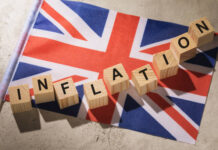Markets
Today’s economic calendar put Europe in the spotlights. First quarter economic growth as expected slowed from 0.3% to 0.2% q/q, in part thanks to Germany that was able to avoid a recession with a 0.2% expansion. Year-over-year, Europe’s economy grew 5%. Details from France and Belgium gave some minor insights into the composition. French consumer spending declined while capital formation provided some counterweight. A sectoral divide by the National Bank of Belgium showed the services sector leading (meagre) growth over there. Growth going forward, however, is what matters. One element central to that is sky high inflation that’s eroding purchasing power. And the April reading published today suggests no huge turnaround is in the making. Headline inflation may have stabilized at a record 7.5% y/y (0.6% m/m) as widely expected but core inflation accelerated more than foreseen, from 2.9% to 3.5% y/y (3.2% expected). This reveals how broad-based price pressures have become. Services inflation for example rose to 3.3%, equaling the previous EMU record in 2002. European yields rose in response, adding more than 7 bps at the front end of the curve. Both the 2y (0.98%) and the 10y European swap yield (1.7%) surpassed the previous cycle/multiyear top. Once again, the move higher was driven by inflation expectations with markets ramping up the pressure on the ECB to finally act. The 10y inflation swap hit a new record high of 3.12%. US yields were initially lured higher by the EU until a batch of economic data (income, spending) provided them their own reasons for exploring new intraday highs. PCE inflation (6.6% headline, 5.2% core) was no big surprise after yesterday’s string of data. The closely watched (by the Fed) employment cost index rose a more-than-expected 1.4%, up from 1% in 2021Q4. It definitely caught markets’ eye just days ahead of the Fed policy meeting (May 4). US yields rise 8.3 bps to 12.8 bps in a textbook bear flattener. Money markets again fully price in four consecutive 50 bps moves, starting next week.
The dollar took a breather nevertheless. One can’t blame the US currency after such a surge over the previous days. The trade-weighted DXY “retreated” from 103.62 to 103.22. EUR/USD tried to capitalize in early dealings but realized that’s useless unless it gets unconditional backing from the ECB. The cross is filling bids near 1.053, barely up from this morning’s 1.05. Sterling is better bid, both against the USD and the euro. GBP/USD rebounded from the 1.25 big figure to 1.254. For comparison purposes: end last week, cable was still trading above 1.30. EUR/GBP declines back below 0.84 to find support around 0.838 (Nov 21 lows). Next week will be a pivotal one for sterling too. The Bank of England meets and will have new forecasts to share. The BoE is walking a tightrope between fighting inflation and an escalation cost-of-living crisis deteriorating the outlook. News Headlines
The Bank of Russia cut its key policy rate by 300 bps from 17% to 14%. Markets expected a smaller cut to 15%. With price and financial stability risks no longer on the rise, conditions have allowed to cut the key policy rate, according to the central bank. If the economy and inflation develop as expected, the Bank of Russia sees more room for additional interest rate cuts this year. The key rate is forecast to average 12.5-14% this year, 9-11% next year and 6%-8% in 2024. Annual inflation is forecast to hit 18%-23% this year, before slowing down to 5%-7% next year and return to the (inflation) target of 4% in 2024. Russian GDP is expected to shrink by 8% to 10% this year, mainly due to supply-side factors. Interestingly, the policy statement doesn’t mention the war at all.
Polish inflation accelerated once more in April, rising by 2% M/M from 11% Y/Y to 12.3% Y/Y (vs 11.4% expected). Food prices were the main culprit, jumping by 4.2% M/M. However, core inflation rose above 8% Y/Y as well, sending a strong signal to the National Bank of Poland to extend its aggressive tightening cycle. We pencil in another 100 bps rate hike next week. The Polish zloty initially gained from EUR/PLN 4.70 towards 4.65 before returning some of those gains. In another CE data release, Czech GDP grew by 0.7% Q/Q in Q1 (4.6% Y/Y). Details aren’t available yet.













